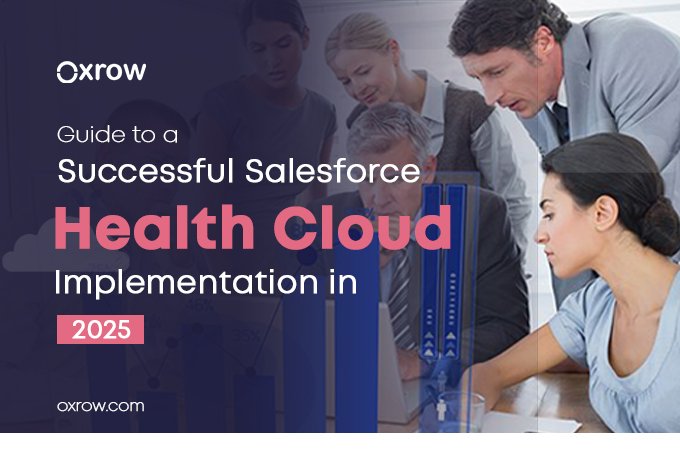It’s 2025, and the healthcare environment is transformed. No more are the days when patients’ interaction with their provider was restricted to sporadic visits and extended waiting periods. Patients now demand the same degree of responsiveness, personalization, and ease of healthcare experience that they would demand from apps like Netflix or Amazon. And healthcare organizations? They are no longer service organizations — they are becoming digital-first, patient-centered ecosystems.
It did not happen overnight. One of the strongest catalysts for this shift is Salesforce Health Cloud, a next-generation CRM platform that is built to meet the advanced needs of healthcare today. It’s no longer just storing data; it’s linking patients, caregivers, and data in a single, intelligent experience.
Here in this blog, we will understand what Salesforce Health Cloud is, what it offers, how it is used today, the key benefits it has to offer, and how to successfully implement Salesforce for healthcare in 2025
What is Salesforce Health Cloud? (Salesforce healthcare CRM explained)
Salesforce Health Cloud is a healthcare cloud platform designed specifically for the healthcare industry, founded on the solid pillars of Salesforce’s tested infrastructure. It is designed for providers, payers, and life sciences companies, a revolutionary solution that unites clinical and non-clinical data to provide smarter, more personalized care.
At its core, Health Cloud brings people (patients, members, care teams) together with systems (EHRs, wearables) and information in one platform, in real-time, enabling them all to make choices and attain better results.
Key Features of Salesforce Health Cloud in 2025

What makes Health Cloud 2025 so special? Let’s take a glance at the most important features:
360-Degree Patient/Member View
Packages several unconnected sources of patient information, such as EHRs, lab systems and wearable devices, into one, unified profile. A care coordinator can see everything from recent vital signs to upcoming appointments at a glance.
Care Coordination Tools
Task management, sharing of care plans, and views of patient timelines keep multidisciplinary teams connected even between organizations or specialties.
EHR Interoperability & Integration
Smoothly integrates with large Electronic Health Record systems via APIs and HL7/FHIR standards to provide bi-directional data sharing without disrupting workflows.
Security & Compliance
HIPAA and HITRUST compliant, with sophisticated user authentication, audit trails, and encrypted data. Patient privacy is always protected; a non-negotiable in healthcare.
Mobile-First & AI-Powered Workflows
Designed for today’s healthcare delivery, the mobile-facilitated platform enables remote care team collaboration, expanding AI capability to decision and next-best action support.
Salesforce Health Cloud is not a flashy dashboard. It is really revolutionizing the delivery of care. The following are a few actual use cases:
Chronic Condition Management
For diabetes, heart disease, or other chronic patients, Health Cloud assists care teams by tracking metrics over time, actively engaging, and modifying care plans as required. It also integrates with remote monitoring devices to provide real-time notifications.
Post-Acute Care Transitions
Continuity of care is most essential at the discharge of the patient from hospital. Health Cloud facilitates improved handoffs of patients from inpatient, outpatient and home care clinicians, lowering the risk of readmission.
Telehealth & Virtual Care Coordination
Health Cloud provides virtual visits and follow-ups through video calling and automated documentation of encounters in the patient record.
Health Plan Member Involvement
For payers, it enables targeted outreach by health risk scores, member behavior and history patterns, helping drive wellness program participation and reduce overall costs.
Step-by-Step Health Cloud Setup Guide
Salesforce Health Cloud isn’t just a tool, it is also a catalyst for change, and only a successful Salesforce implementation of the cloud is of the utmost importance, but it also requires a little more than flipping a switch.
1. Start with the Patient Journey
Map out key touchpoints across the care experience to guide how Health Cloud supports real needs.
2. Build Cross-Functional Teams
Involve clinical, operational, and IT stakeholders early to align workflows and drive adoption.
3. Integrate Data Seamlessly
Use HL7/FHIR standards to connect EHRs, devices, and legacy systems, making patient data accessible and actionable.
4. Design for Users, Not Just Processes
Configure workflows that simplify daily tasks and support smarter, faster care decisions.
5. Embrace AI & Automation from Day One
Use Einstein and built-in automation to predict needs, streamline scheduling, and personalize engagement.
6. Start Small, Scale Fast
Begin with one high-impact use case like chronic care or discharge planning, then expand as results grow.
Want to Revolutionize Patient Care With Salesforce Health Cloud?
Your patients expect smarter care. We help you deliver it. At Oxrow, we specialize in Salesforce Health Cloud consulting services that modernize care coordination, unify patient data, and boost engagement with AI-powered precision.
Top Innovations in Salesforce Health Cloud In 2025

Salesforce isn’t taking any chances. Health Cloud in 2025 is more integrated and intelligent than ever, with game-changing features:
- AI-Powered Care Predictions (Einstein) – Salesforce Einstein analyzes patient behavior and history to predict events like hospital readmission or no-shows, allowing for pre-emptive contact and resource planning.
- Integration with Wearables & IoT Devices – Whether it’s an Apple Watch monitoring heart rate or a glucose meter uploading in real-time, Health Cloud integrates wearable health data effortlessly for continuous monitoring.
- Smart Scheduling & Virtual Agent Tools – AI bots assist with appointment booking, pre-visit questionnaires and follow-ups, drastically reducing no-shows and improving operational efficiency.
- Real-Time Care Insights Dashboards – Care teams can now see live visual dashboards of patient trends, risk scores, and outcome measures, enabling data-driven changes in strategy.
Conclusion: Ready to Implement Salesforce for Healthcare Success?
A strategic step towards the future of care, Salesforce Health Cloud is not just another technology innovation; it’s a bet on the future of care delivery. As healthcare continues to digitize and decentralize, Health Cloud platforms ensure payers and providers are not only keeping up but staying ahead of the game.
If you want to make sure that your business stays ahead with AI-driven insights, book a consultation with us at Oxrow and talk to our Salesforce Health Cloud experts!
